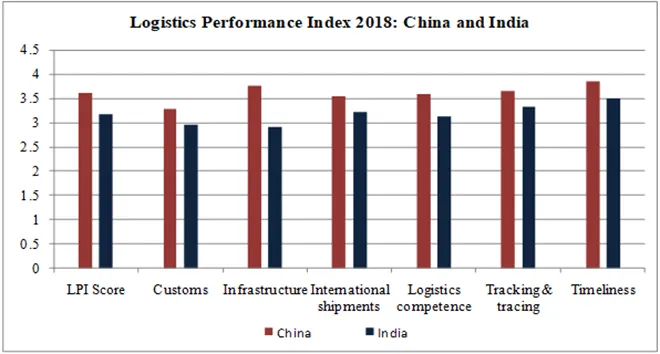-
CENTRES
Progammes & Centres
Location
বিভিন্ন অর্থনৈতিক ক্ষেত্র জুড়ে বহু সংখ্যক ব্যক্তিগত বিনিয়োগকারীর উত্থানের সঙ্গে সঙ্গে ব্যবসায়িক কার্যকলাপকে সমর্থন জোগানোর জন্য গুণমানসম্পন্ন পরিকাঠামোর নির্মাণ অত্যন্ত গুরুত্বপূর্ণ হয়ে উঠেছে।

ভারতীয় পরিকাঠামো: অতীতের অভিজ্ঞতাকে কাজে লাগিয়ে ভবিষ্যতের বৃদ্ধি সুনিশ্চিত করা
২০২৫ সালের মধ্যে ৫ ট্রিলিয়ন মার্কিন ডলার মূল্যের অর্থনীতি হয়ে ওঠার স্বপ্নের বাস্তবায়ন এখনও পর্যন্ত ভারতের যাত্রাপথের এক উল্লেখযোগ্য মাইলফলক হতে পারে। যদিও কোভিড-১৯ অতিমারির ফলাফল এবং জারি থাকা বিশ্বব্যাপী অর্থনৈতিক মন্দার সঙ্গে যুঝতে ভারতকে নিজের অগ্রাধিকার নির্ধারণে সুনিশ্চিত হতে হবে এবং একটি বৈশ্বিক শক্তিতে রূপান্তরিত হওয়ার জন্য কার্যকরী কৌশল গ্রহণ করতে হবে। একই সঙ্গে বৈশ্বিক বাজারে নিজের প্রাসঙ্গিকতা অর্জনের পাশাপাশি ভারতকে আত্মনির্ভর হতে হবে এবং দেশের জনগণ এবং অভ্যন্তরীণ বাজারের জন্য উচ্চতর স্থিতিস্থাপকতা সুনিশ্চিত করতে হবে। সীমিত অর্থায়নের ক্ষমতাসম্পন্ন একটি উন্নয়নশীল দেশ হওয়ার দরুন ভারতকে সেই সব গুরুত্বপূর্ণ ক্ষেত্র চিহ্নিত করতে হবে, যেগুলি আগামী কয়েক বছরে তার বৃদ্ধির কর্মসূচিকে কার্যকর ভাবে এগিয়ে নিতে যেতে সক্ষম। অর্থনীতির বিভিন্ন ক্ষেত্রে বিস্তৃত ভারতের সম্পদগুলি শুধু মাত্র ভোগ্যপণ্য এবং পরিষেবা উৎপাদনকারী কারখানা, উৎপাদনকেন্দ্র অথবা যান্ত্রিক ব্যবস্থার মতো ভৌত পুঁজিতেই সীমাবদ্ধ নয়, বরং স্বাস্থ্য ও শিক্ষার মতো মানবিক ও সামাজিক সম্পদের পাশাপাশি উৎপাদন প্রক্রিয়াকে সমৃদ্ধকারী ব্যাপক প্রাকৃতিক পুঁজি দ্বারাও প্রভাবিত।
সীমিত অর্থায়নের ক্ষমতাসম্পন্ন একটি উন্নয়নশীল দেশ হওয়ার দরুন ভারতকে সেই সব গুরুত্বপূর্ণ ক্ষেত্র চিহ্নিত করতে হবে, যেগুলি আগামী কয়েক বছরে তার বৃদ্ধির কর্মসূচিকে কার্যকর ভাবে এগিয়ে নিতে যেতে সক্ষম।
যদিও এই সকল সম্পদের উৎপাদনশীলতা ভারতের পরিকাঠামো ক্ষেত্রের উন্নয়নের উপর উল্লেখযোগ্য ভাবে নির্ভরশীল। ভারতের পরিকাঠামো ক্ষেত্রের প্রাথমিক গুরুত্ব অনুযায়ী, ২০২২-২৩ অর্থবর্ষের কেন্দ্রীয় বাজেটে ভারতকে এক স্থিতিশীল এবং স্থিতিস্থাপক ভবিষ্যতের দিকে চালিত করবে এমন গুরুত্বপূর্ণ সংযোগ স্থাপনকারী প্রকল্পগুলির জন্য মূলধন বিনিয়োগের এক ব্যাপক পরিকল্পনার কথা তুলে ধরা হয়েছে। যদিও এই সুযোগগুলিকে কার্যকরী ভাবে কাজে লাগিয়ে সামনের দিকে এগিয়ে যেতে ভারতকে অবশ্যই তার অতীত থেকে শিক্ষা গ্রহণ করতে হবে।
পরিকাঠামো নির্মাণ অর্থনৈতিক বৃদ্ধির একটি অপরিহার্য অংশ হিসেবে উঠে এসেছে। উৎপাদনশীলতার উপর এর সুস্পষ্ট প্রভাব এবং বিভিন্ন অর্থনৈতিক ক্ষেত্রে উৎপাদনের খরচ কমানোর পাশাপাশি, পরিকাঠামোর পর্যাপ্ততা এবং এর কার্যকরী দক্ষতা একটি দেশের উন্নয়নের ধারায় গুরুত্বপূর্ণ ভূমিকা পালন করে। যেমন উৎপাদন বহুমুখীকরণ, বর্ধিত প্রতিযোগিতার মাধ্যমে বাণিজ্য সম্প্রসারণ, পরিবেশগত অবস্থার উন্নতি সাধন এবং উপার্জনক্ষম নয়, এমন ক্ষেত্রগুলির মাধ্যমে বহুমাত্রিক দারিদ্র্য হ্রাস।
যদিও ভারতে পরিকাঠামো নির্মাণের দিকটি চিরাচরিত ভাবে পরিকল্পনার বাস্তবায়ন অথবা কার্যকারিতার ব্যর্থতার পাশাপাশি সামগ্রিক ব্যবসায়িক পরিবেশকে নেতিবাচক ভাবে প্রভাবকারী বৃহৎ নিয়ন্ত্রক কাঠামো দ্বারা প্রভাবিত হয়। বিশেষত সকল ব্যবসায়িক ক্ষেত্রব্যাপী গুরুত্বপূর্ণ সংযোগকারী লজিস্টিক ক্ষেত্রটিতে কর্মক্ষমতার দিক থেকে ঘাটতি রয়েছে। নিচের চিত্রটি ২০১৮ সালের বিশ্ব ব্যাঙ্কের লজিস্টিকস পারফরমেন্স ইনডেক্স-এর (এল পি আই) ভিত্তিতে ভারত ও চিনের মধ্যে একটি তুলনা উপস্থাপন করে। শুল্ক বিভাগ, বিদ্যমান পরিকাঠামো (পরিমাণ), আন্তর্জাতিক রফতানির পরিমাণ, লজিস্টিক ব্যবস্থার দক্ষতা, ট্র্যাকিং ও ট্রেসিং পদ্ধতি, সময়োপযোগিতা এবং সামগ্রিক কর্মক্ষমতার নিরিখে চিন ভারতের চেয়ে উল্লেখযোগ্য রকম ভাবে এগিয়ে রয়েছে। ২০১৮-এর এল পি আই ক্রম অনুযায়ী ৩.৬১ স্কোর নিয়ে চিন ২৬তম স্থানে, যেখানে সামগ্রিক লজিস্টিক কর্মক্ষমতার নিরিখে ৩.১৮ স্কোর নিয়ে ভারত ৪২তম স্থানে রয়েছে। সকল ক্ষেত্রের নিরিখে ভারত ও চিনের মধ্যে সবচেয়ে বড় ফারাক পরিলক্ষিত হয়েছে পরিকাঠামোর ক্ষেত্রে, যা স্বয়ংক্রিয় ভাবে বিদ্যমান ক্ষমতার উপর অযথা উচ্চ চাপ প্রদানের কারণে অন্যান্য নিয়ন্ত্রক ও ব্যবহারিক শ্লথতায় পরিণত হয়েছে।
চিত্র ১: ২০১৮ সালে চিন ও ভারতের লজিস্টিকস পারফরমেন্স ইনডেক্স স্কোর

পরিকাঠামো নির্মাণে বিনিয়োগগুলি সাধারণত পরিচালনা এবং রক্ষণাবেক্ষণ-সহ সরকারি খাত দ্বারা পরিচালিত হয়। এগুলি সরকারি কোষাগার থেকে মূলধনী ব্যয়ের একটি অংশকেই তুলে ধরে, যা অর্থনীতিতে উত্পাদনশীল সম্পদ তৈরিতে সরাসরি অবদান রাখে। যদিও সরকারি ব্যয় (রাজস্ব এবং মূলধনী ব্যয় উভয় নিরিখেই) চাহিদা সৃষ্টির মাধ্যমে উচ্চ স্তরের অর্থনৈতিক বৃদ্ধি সূচিত করে এবং প্রতিটি ক্ষেত্রের উপরেই এগুলির প্রভাব বিশেষ ভাবে আলাদা। রাজস্ব ব্যয় সরাসরি অর্থনীতিতে উচ্চ সামগ্রিক চাহিদার সৃষ্টি করে, বাজারের চাহিদা বৃদ্ধির পরবর্তী পর্যায়গুলির জোগান দেয় এবং তার ফল স্বরূপ অর্থনীতির উত্পাদনশীল ক্ষমতা পরিবর্তন না করেই উচ্চতর বৃদ্ধি সূচিত হয়। অন্য দিকে পরিকাঠামো নির্মাণে মূলধনী ব্যয় সরাসরি উচ্চ স্তরের সামগ্রিক চাহিদা তৈরি করার পাশাপাশি, উৎপাদনশীলতার উন্নতি এবং মুনাফার হারের সামঞ্জস্যপূর্ণ বৃদ্ধি ও ব্যক্তিগত বিনিয়োগের মাঝে উৎপাদন খরচ হ্রাসের দিকেই পরিচালিত করে। ভারতীয় প্রেক্ষাপটেও এটি সত্য বলে প্রমাণিত হয়েছে। রাজস্ব ব্যয় (বা সরাসরি স্থানান্তর অর্থপ্রদান) খাতের জন্য ভারত সরকার দ্বারা নিয়োজিত ১ ভারতীয় টাকা গড়ে অতিরিক্ত ১ ভারতীয় টাকার সমান মূল্যের উপার্জন সুনিশ্চিত করে, যেখানে মূলধনী ব্যয়ের জন্য আয়ের বৃদ্ধি ২.৪৫ ভারতীয় টাকা।
এ ছাড়া অর্থনৈতিক মন্দার সময়ে আর্থিক সম্প্রসারণ আয় বৃদ্ধির উপর বিপরীত প্রভাব ফেলতে পারে। কিন্তু বেশির ভাগ উন্নয়নশীল দেশের মতোই ভারতের আর্থিক অবস্থার সুদৃঢ়করণের প্রয়োজনীয়তা প্রায়শই তার মূলধনী ব্যয়কে সঙ্কুচিত করে, অর্থাৎ ঘাটতি পূরণের নিরিখে শেষ পর্যন্ত একটি বৃহত্তর প্রভাবকে প্ররোচিত করতে পারে। বিশেষ করে দীর্ঘমেয়াদে সামগ্রিক ফলাফল সঙ্কোচনের মাধ্যমে। সুতরাং রাজস্ব ব্যয় সম্প্রসারণের মাধ্যমে সামষ্টিক অর্থনৈতিক স্থিতিশীলতা সক্ষম করার জন্য, মোট অভ্যন্তরীণ উৎপাদনের (জি ডি পি) অংশ হিসাবে মূলধনী ব্যয়ের স্তরের নিরিখে প্রয়োজনীয় সাবধানতা অবলম্বন জরুরি হয়ে ওঠে।
রাজস্ব ব্যয় সরাসরি অর্থনীতিতে উচ্চ সামগ্রিক চাহিদার সৃষ্টি করে, বাজারের চাহিদা বৃদ্ধির পরবর্তী পর্যায়গুলির জোগান দেয় এবং তার ফল স্বরূপ অর্থনীতির উত্পাদনশীল ক্ষমতা পরিবর্তন না করেই উচ্চতর বৃদ্ধি সূচিত হয়।
এতে কোনও সন্দেহ নেই যে পরিকাঠামোয় বিনিয়োগের জন্য মূলধনী ব্যয়ের প্রয়োজনীয়তা ব্যাপক হওয়ার পাশাপাশি অপেক্ষাকৃত দীর্ঘতর প্রক্রিয়াগত সময়ে তাদের তাত্ক্ষণিক এবং সামষ্টিক প্রভাব দুই-ই বেশি। এর পাশাপাশি পরিকাঠামোর উন্নয়নে সুনির্দিষ্ট ও সময়োপযোগী বিনিয়োগও অত্যন্ত গুরুত্বপূর্ণ। পরিকাঠামোর ‘পরিমাণ’-এর উপর নজর দেওয়ার পরিবর্তে তার কর্মক্ষমতার ‘গুণমান’ উন্নত করার জন্য দৃষ্টিভঙ্গির পরিবর্তনের উপরে জোর দিয়ে বিশ্ব ব্যাঙ্ক তিনটি প্রধান সুপারিশ করে। এর মধ্যে রয়েছে বাণিজ্যিক নীতির ব্যাপক প্রয়োগ যেমন ব্যবস্থাপনাগত স্বায়ত্তশাসন; সরকারি-বেসরকারি অংশীদারিত্বের আকারে বৃহত্তর বেসরকারি খাতের নিযুক্তির মাধ্যমে ক্ষেত্রটিকে আরও প্রতিযোগিতামূলক করে তোলা; এবং অন্তিম উপভোক্তা-সহ প্রধান অংশীদারদের প্রতি দায়িত্ব ও দায়বদ্ধতা বৃদ্ধি করা। পর্যাপ্ত দায়বদ্ধতা ব্যতীত এই ক্ষেত্রটিকে উল্লেখযোগ্য অকার্যকারিতা এবং ক্ষমতার সদ্ব্যবহার না করা দ্বারা চিহ্নিত করা যেতে পারে।
ভারতে অর্থনৈতিক ক্ষেত্র জুড়ে বিপুল সংখ্যক ব্যক্তিগত বিনিয়োগকারীর উত্থানের পাশাপাশি ব্যবসায়িক কার্যকলাপকে সমর্থনকারী গুণমানসম্পন্ন পরিকাঠামো উন্নয়ন অত্যন্ত গুরুত্বপূর্ণ ক্ষেত্র হয়ে উঠেছে, যা সরকারের সব স্তরের তীব্র মনোযোগ দাবি করে৷ পরিকাঠামো ক্ষেত্রটিতে প্রাথমিক ভাবে ভৌত এবং ডিজিটাল সংযোগ ব্যবস্থার পাশাপাশি শক্তি এবং জ্বালানির দিকগুলিও অন্তর্ভুক্ত রয়েছে। ভারতে মূলধনী ব্যয় (মোট ব্যয়ের একটি অংশ হিসাবে) বৈশ্বিক মানদণ্ডের নিরিখে বেশ নিচের দিকে থাকলেও গত পাঁচ বছরে পরিকাঠামো প্রকল্পগুলিতে বিনিয়োগে ধারাবাহিক ভাবে বৃদ্ধি লক্ষ করা গিয়েছে।
দেশে স্থিতিশীল অর্থনৈতিক বৃদ্ধি এবং উন্নয়ন নিশ্চিত করার জন্য ২০১৯-২০২৩ সালের মধ্যে আনুমানিক ১.৪ ট্রিলিয়ন মার্কিন ডলার ব্যয়ের পরিকল্পনায় পরিকাঠামো খাতটি সরকারের অন্যতম প্রধান মনোযোগের কেন্দ্র হয়ে উঠেছে। একই সঙ্গে ভারত পরিকাঠামো উন্নয়ন ক্ষেত্রে ব্যাপক বিনিয়োগের মাধ্যমে তার ‘অ্যাক্ট ইস্ট’ কর্মসূচিকে এগিয়ে নিয়ে যাওয়ার জন্য জাপানের মতো বিশিষ্ট আঞ্চলিক অংশীদারদের সঙ্গে হাত মিলিয়েছে। এর ফলে বাণিজ্যিক অংশীদারদের মধ্যে কার্যকরী সমন্বয় সাধন, লেনদেনের খরচ হ্রাস এবং ভারতের পাশাপাশি একাধিক দেশব্যাপী পণ্য ও পরিষেবাগুলির নির্বিঘ্ন চলাচলের মাধ্যমে এর আঞ্চলিক অর্থনৈতিক সমন্বয় ব্যবস্থার অগ্রগতি ঘটবে।
চিহ্নিতকরণ ও সমাধানের প্রয়োজনীয়তা-সহ বেশ কয়েকটি বিদ্যমান সমস্যার দরুন ভারতে লজিস্টিক ব্যয় বৈশ্বিক মানদণ্ডের তুলনায় উল্লেখযোগ্য ভাবে বেশি।
যদিও পরিবহণ এবং ডিজিটাল সংযোগে্র ক্ষেত্রে পরিকাঠামোয় বিনিয়োগের জন্য চাপ প্রদানের পাশাপাশি, কেন্দ্রীয় ও রাজ্য সরকারের বিভিন্ন বিভাগের মধ্যে দক্ষ সমন্বয় ব্যবস্থা গড়ে তোলা প্রয়োজন। চিহ্নিতকরণ ও সমাধানের প্রয়োজনীয়তা-সহ বেশ কয়েকটি বিদ্যমান সমস্যার দরুন ভারতে লজিস্টিক ব্যয় বৈশ্বিক মানদণ্ডের তুলনায় উল্লেখযোগ্য ভাবে বেশি। এক মাত্র তা হলেই ‘প্রধানমন্ত্রী গতি শক্তি জাতীয় মহাপরিকল্পনা’ উদ্যোগের অধীনে, পরিকল্পিত পরিকাঠামো উন্নয়নের একটি সমন্বিত দৃষ্টিভঙ্গি মাল্টি-মোডাল সংযোগ ব্যবস্থার মাধ্যমে এক প্রান্ত থেকে অন্য প্রান্তে নিরবচ্ছিন্ন সংযোগ ব্যবস্থা স্থাপন করতে পারে এবং অর্থনৈতিক বৃদ্ধিতে অবদান রাখে এমন শিল্পাঞ্চলগুলির বিকাশকে সুনিশ্চিত করতে পারে। এর পাশাপাশি, এই উদ্যোগ স্থিতিশীল উন্নয়ন কর্মসূচির আওতায় শিল্পাঞ্চলের বিকাশ এবং পরিবেশগত উদ্বেগের নিরিখে প্রতিদ্বন্দ্বিতামূলক লক্ষ্যগুলিকে একত্র করার সুযোগ তৈরি করতে পারে, বিদ্যমান বাণিজ্যিক সম্পর্ককে কার্যকর সমন্বয়ে রূপান্তরিত করতে এবং ভারতের জন্য একটি সবুজ রূপান্তরকে সূচিত করতে সক্ষম।
আগামিদিনে ভারতের সম্মুখে সবচেয়ে গুরুত্বপূর্ণ চ্যালেঞ্জ হবে পরিকাঠামো বিনিয়োগের ক্ষেত্রে তার উদ্যোগ ও প্রকল্পগুলির সফল বাস্তবায়ন ও সময়োচিত সমাপ্তির জন্য প্রয়োজনীয় পরিবেশের মধ্যে ভারসাম্য বজায় রাখা। পরিকাঠামোগত উন্নয়নে এই পরিপূরক ব্যবস্থাগুলির বাস্তবায়ন আগামী দশকে ভারতের বৃদ্ধির সম্ভাবনার লক্ষ্য পূরণে গুরুত্বপূর্ণ ভূমিকা পালন করতে পারে।
মতামত লেখকের নিজস্ব।
The views expressed above belong to the author(s). ORF research and analyses now available on Telegram! Click here to access our curated content — blogs, longforms and interviews.

Debosmita Sarkar is an Associate Fellow with the SDGs and Inclusive Growth programme at the Centre for New Economic Diplomacy at Observer Research Foundation, India. Her ...
Read More +